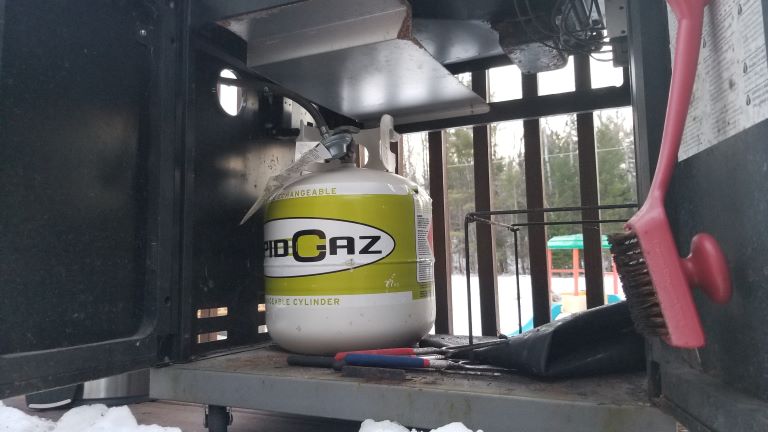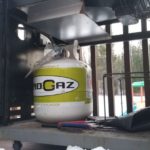Enjoy this quick guide on how to change a propane tank so that you can get back to grilling in a flash.

Picture this…it’s a beautiful sunny day. You’ve got the steak marinated and the grill preheated and ready to go. You throw the steaks on the grill and crack a cold one! Then…..BAM! The grill shuts down and you’re out of propane.
These things always happen at the most inopportune times.
Hopefully you’ve got a backup propane tank that’s full and ready for a quick swap. Otherwise, you’ll find yourself running to the closest gas station for a refill.
In either event, do you know how to change a propane tank?
For many people that have never had to, you might not know where to start.
Thankfully, it’s really not too difficult, but there are a few steps you should follow each time for safety reasons and to avoid damage to your grill or propane tank.
In this guide we’ll walk you through the process so you can be up and running before the ice in your drink has melted.
How to Remove a Propane Tank from a Grill
The first step to changing your propane tank is to remove the old one and confirm that it is indeed empty.
Open up the front doors on your grill and notice the propane tank positioned inside.

Turn the valve located on top of the tank clockwise until it is fully closed.
Next, disconnect the hose attaching the propane tank to the grill. This is usually a large black connector that can be turned counterclockwise to remove.
Once the hose has been disconnected, remove the propane tank from the grill. It should be quite light and feel empty. If it feels like there is still propane in the tank, there may be an issue with the grill.
Now that you’ve got the tank removed, it’s time to install the new or refilled tank.
How to Connect a Propane Tank to a Grill
Before connecting the new tank to the grill, take this as an opportunity to inspect the grill’s gas hose and coupler for any damage.
Check it over quickly for cracks or dirt that could allow a gas leak. Blow any dirt out or wipe with a cloth.
Always replace any damaged parts before installing a new tank. (link to a gas hose)
If everything looks good with the connectors, place the propane tank in its holder underneath the grill.
Connect the gas hose to the propane tank by turning the connector clockwise this time. The connection should be made finger tight. Avoid over-tightening which could cause the coupler to crack.
Next, you’ll need to know how to turn the propane back on for your grill. To do this, turn the propane tank valve to the open position by turning it counterclockwise.
You now know how to change a propane tank and you’re ready to light the grill and begin cooking.
Signs a propane tank is low
A propane tank that is low in fuel will feel light. That’s because the liquid propane has been used and all that is left is the weight of the tank itself.
How to check how much propane is left in the tank
If you want to know precisely how much propane is left in your tank, the simplest way is to weigh the tank. To complete this, weigh the tank and subtract the TW (tare weight) number indicated on the tank. The resulting number is the weight of the remaining propane.
Another way to check how much propane is in the tank is to purchase a gauge and install it. That way, you will always know how much you have left.
Grill ignitor not working
If your push start grill ignitor is not working, there is a good chance that the battery inside has died. Replacing it is simple, although it will vary by the type of grill you own. Typically the battery is located inside a compartment underneath the button. Look for a way to unscrew the button and replace the battery.
If you enjoy grilling, you’ll love this list of some of the best swivel grills for fire pits on the market today. There’s just nothing like cooking over an open flame while out camping.
We love writing about the things that make a real difference in your outdoor experience. Some of the links in this post are affiliate links in which case we may earn a small commission at no extra cost to you if you make a purchase. We truly appreciate you taking the time to read our content and hope it has added value to your next camping and outdoor adventure.





Great content! Keep up the good work!
Thank you for the kind words! They really mean a lot to me.
Everyone loves it when individuals come together and share thoughts. Great site, keep it up!
Thank you!! I plan to add as much practical content as I can possibly write. If these pieces provide some answers to peoples camping or outdoor questions, then I will consider it a success. Thank you for reading.